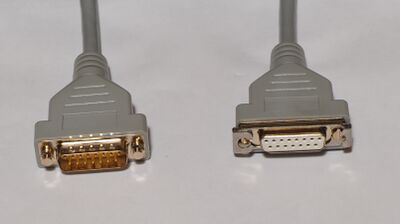Ethernet transceiver
An Ethernet Transceiver connects one of the following Ethernet cable types:
- Thickwire Coaxial
- Thinwire Coaxial
- Twisted Pair
- Fibre Optic (different types)
to an Ethernet interface using a Tranceicver cable.
Most modern standard Ethernet interfaces have got the Transceiver included in the network interface module (resp. interface chip), so that neither separate Tranceiver nor Transceiver cable are needed.
A lot of recent high-speed Ethernet interfaces (1 GB/s and above) and Switches have Transceivers again. They enable to flexibly adapt to different network media, e.g. different types of Fibre Optic cables.
<Picture of a recent Transceiver module>
Transceiver Cables
Ethernet Transceiver Functions
From "EK-H4000-TM-PRE H4000 Ethernet Transceiver Technical Manual", chapter 1.2.2 "Transceiver Functional Description":
The transceiver performs the following functions:
- Transmit: Responds to the signals input from the transceiver cable and transmits the signals on the coaxial cable.
- Receive: Responds to signals transmitted on the coaxial cable and couples the received signals to the transceiver cable.
- Collision Detect: Monitors the signals transmitted on the coaxial cable and, if a collision occurs, signals appropriately on the transceiver cable.
Additionally, the transceiver does the following:
- Maintains electrical isolation between the coaxial cable and the transceiver cable,
- Maintains low loading/high impedance on the coaxial cable,
- Provides continuous data loopback (i.e., the receiver portion of the transceiver is always active; thus, the message being transmitted is coupled back on the transceiver cable),
- Provides self test of the collision detection circuitry at the end of each transmission,
- Contains protective circuitry which ensures that network integrity will be maintained in the event of a faulty transceiver, controller, or repeater.
